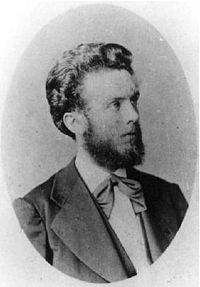Heinrich Edmund Naumann
| Heinrich Edmund Naumann | |
|---|---|

Heinrich Edmund Naumann
|
|
| Born | September 11, 1854 Meissen, Germany |
| Died | February 1, 1927 (aged 72) Frankfurt, Germany |
| Nationality |
|
| Fields | geology |
| Known for | Fossa Magna () |
Heinrich Edmund Naumann (September 11, 1854 – February 1, 1927) was a German geologist, regarded as the “father of Japanese geology” in Meiji period Japan.
Heinrich Edmund Naumann was hired by the Meiji government in 1875 as a foreign advisor, with the task of introducing the science of geology to Japan through his teaching at the Kaisei Gakkō, the forerunner to Tokyo Imperial University.
Naumann arrived in Japan just one month before his twenty-fifth birthday, receiving a yearly salary of 3600 yen. Overall, he spent ten years in Japan, and wrote numerous scientific papers, most of which remain untranslated from the original German. During his early years in Japan, he both cooperated with, and competed against, fellow geologist John Milne. Both were part of the European scientific community interested in exploring the origins of the earth and the fledgling science of vulcanology. In 1877, Naumann and Milne investigated a volcanic eruption on the island of Izu Ōshima near Tokyo. However, by the 1880s, Milne focused more on seismology, whereas Naumann concentrated on his attempts to complete a geological map of the Japanese archipelago.
Naumann conducted numerous geological surveys, traveling over 10,000 kilometers within Japan, covering almost every province in Honshū, Kyūshū and Shikoku. In 1879, Naumann began publishing his ideas of the geological origins of the Japanese archipelago, which he speculated was created from three major foldings of the Earth’s crust, in the pre-Paleozoic, late Paleozoic and Miocene era, and that Japan was composed of two major mountain systems, in the southwest and the northeast. The divide between these mountain systems, a great fault zone which vertically divides the main Japanese island of Honshū from the Izu peninsula in the southwest to Toyama in the northeast, he labeled the Fossa magna.
...
Wikipedia
